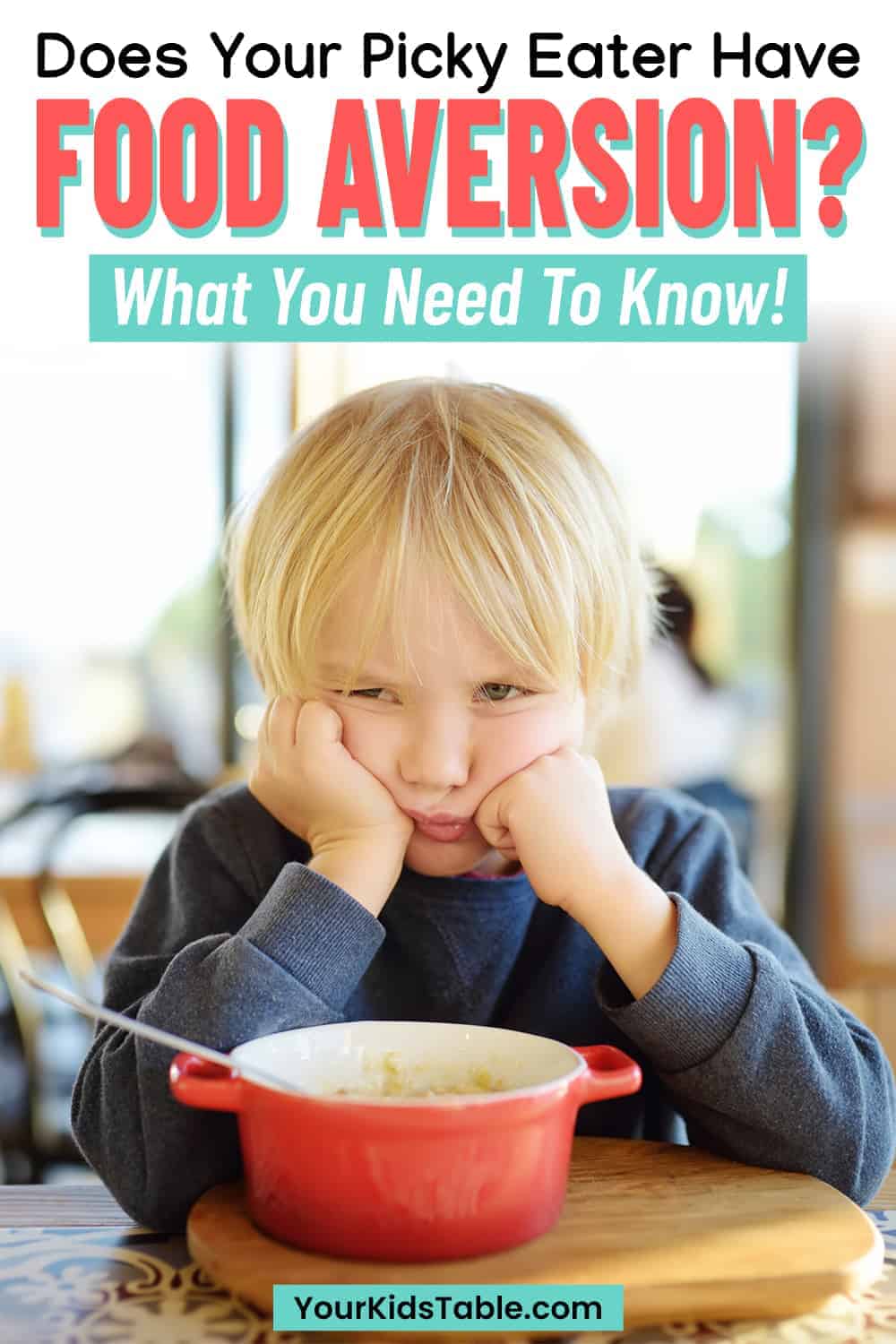Learn what a food aversion is, how it affects toddlers and kids, and when it’s a sensory food aversion!
Some kids utterly refuse to eat a particular food(s), often the foods parents consider “healthy”. Or, they’re disgusted by strong smells and have food preferences that they will not stray from. Do they have a food aversion???
What is a Food Aversion?
A food aversion is when a child consistently refuses to eat specific foods, typically having an impact on the variety of nutrients in their diet. Kids and toddlers with food aversions usually can’t be coaxed or coerced into trying foods they refuse and may gag or become very upset when they’re offered.
The Sensory Food Aversion
As an occupational therapist, one of the most common causes I see for food aversion is sensory sensitivities to textures and flavors of food. When a child has a sensory food aversion, they will often gag or even vomit at the sight, touch, smell, or taste of new foods.
That’s because their brain is over processing the sensations, which means that the child is intensely and negatively experiencing the smell, texture, or flavor of food. Learn more about the sensory food aversions in kids and how to treat them.
Kids with Sensory Processing Disorder (SPD) are known to have difficulties processing sensory information, and they are more likely to have sensory food aversion. As are kids with Autism Spectrum Disorder (ASD), often because most kids with ASD also have SPD.
But, kids with autism also seek consistency, and prefer to have little changes in lots of areas of their life, which affects mealtimes as well.
Often, kids with sensory food aversion will only eat certain types of food like crunchy foods or sweet foods. Their taste aversions may cause them to refuse anything that’s sour, bitter, or even savory. And, texture aversion may cause them to avoid mixed foods like casseroles, soft food, or pureed food.
Babies with sensory food aversion will often struggle to accept baby food or begin eating table foods.
If you see sensory issues in other areas of your child’s life and they also have a food aversion, it’s likely that sensory is at least part of the reason for the food aversion.

Other Causes of Food Aversions
While sensory food aversion can cause children to be picky eaters and even develop Pediatric Feeding Disorder (PFD), sometimes kids will have one or a few food aversions that don’t affect their nutrition or cause much family stress.
The cause of the food aversion in these cases are often a child has been ill and vomited up the food they ate. A negative association is made between the physical discomfort and the food. Likewise children that have experienced surgical procedures that affect their throat/mouth, had feeding tubes, or been intubated can develop food aversion in general.
Again, they have a negative association with anything near their mouth or throat and want to avoid discomfort which causes them to refuse many or even all foods. As time passes, this begins to affect the sensory system because it’s not being stimulated and then there’s an additional component of a sensory food aversion as well.
This is also true for a host of medical conditions where eating and swallowing are painful or difficult, in which kids don’t want anything even near their face. This is also called oral aversion.
Some kids with Obsessive Compulsive Disorder (OCD) or other anxiety disorders can also develop food aversions if they start to fear that the food is contaminated or could make them sick. For some kids, this can be isolated to a few foods that they may avoid.
Other times, it can become pervasive and if there are no other causes, like sensory food aversion, a child may qualify for an Avoidant Restrictive Food Intake Disorder diagnosis (ARFID) because there is so much anxiety around a large amount of foods.
What About Food Aversion in Toddlers, is it Just Picky Eating??
Of course, if you have a toddler, you’ve probably witnessed food aversion. Many toddlers enter a predictable picky eating phase sometime between 1 and 2 years old. Toddlers may begin to refuse foods they gobbled up as a baby. Or, they may refuse specific foods all together.
Common food aversions for toddlers and kids of any age are vegetables, meat, soft foods, or even dairy products. Of course, it’s possible when a toddler is avoiding a food group like dairy that they have a sensitivity or allergy to that food.
Some food aversions are normal for toddlers. But, if a toddler is avoiding a wide range of foods and their weight/growth and/or significant stress is on the parents at meals, then they might be in extreme picky eating, which is not an expected part of development.
Toddlers may not grow out of extreme picky eating, and it can lead to power struggles and a limited diet for years to come.
Treatment for Food Aversions in Kids and Toddlers
I believe there’s a lot parents can do at home to help their child overcome food aversions. It starts with creating a positive mealtime environment with kids that have some structure and routine.

While these changes are simple, they aren’t always easy because it may take you and your child time to change habits. Some great ways to start are by eating together, not pressuring your child to eat, and serving one food your child eats at each meal.
You can learn more about the foundational, but powerful steps in our free workshop so you can start using them home ASAP. Sign up here.
There are other advanced strategies including food chaining and food play therapy, as well. We teach these inside our Mealtime Works picky eating program in more detail.
If it’s available to you, you also have the option to look for feeding therapy in your local area. This is often housed under speech or occupational therapy. Check with your insurance coverage.
How Long Does it Take a Child to Get Over a Food Aversion?
Depending on the cause of the food aversion, a toddler or child may overcome a food aversion in as little as a few days or as long as a few years. There are dozens of factors that influence the time frame including the severity of the food aversion, the age of the child, and the consistency and follow through of food aversion strategies.
On average, with regular follow through of those strategies, I’d say 3 to 6 months for actually eating new foods, sooner for increased interaction and a decrease of fear of the food aversions.
Have questions about food aversion? Let us know below, we answer every single one!
And, if you want a list of food ideas that are perfect for picky eaters, get the Picky Eater Meal Ideas Printable right to your inbox.
More on Food Aversions and Picky Eating
How to Wean Your Child From Tube Feedings to Eating By Mouth
Mindfulness Activities for Kids With a Poor Appetite
Alisha Grogan is a licensed occupational therapist and founder of Your Kid’s Table. She has over 19 years experience with expertise in sensory processing and feeding development in babies, toddlers, and children. Alisha also has 3 boys of her own at home. Learn more about her here.

12 year old girl. Says she doesn’t like ANY food. Reality is she doesn’t enjoy anything (no pizza, no chocolate, no fries…). We can get through breakfast and lunch but at dinner she will always say she has “nausea”, an extreme fear of vomiting at bed, and will just refuse to eat. She WANTS to gain weight. She is being treated by a nutritionist and a psychologist, goes twice per week to a clinic and spends the morning. She has gained some weight but the eating disorder is still there and hasn’t improved a bit. We’re desperate. Wife is turning aggressive, I try to play good cop but my daughter will just engage in psy warfare.
PJ,
This can be so stressful, and it sounds like you are taking great steps to help this. Does she have an ARFID diagnosis? Do you notice other underlying sensory issues in other areas? If so, she may have a pediatric feeding disorder which is a sensory based feeding issue that can be addressed by an occupational therapist. Not to say what you’re doing isn’t effective, but wondering if there is more to the picture.
Best,
Laura
Your Kid’s Table team member
I’m not sure what to do at this point. I think we are beyond just picky eating. He’s 2.5 and only eat frozen pancakes ( yes still frozen), underripe bananas, yogurt. If he had it his way he would drink milk, water, juice and never eat a single bite. We are on meds to help him trick his brain into being hungry but this is our 2nd time around on it and he just won’t eat.
Casey,
Have you taken our free picky eating workshop yet? If not, start there. We do have resources beyond that, but it is a great starting point.
Best,
Laura
Your Kid’s Table team member
We have a 4yo that has all the aversions and disorders you have mentioned. He was in food therapy since he was 9mo old. Nothing helped. He did OT for a while too and it did nothing. We have done all the things. All the different ways that have been told by numerous specialists. We are exhausted frustrated and desperate to get this boy to eat. As of now he is on the curve but long term effect what is this going to do.
Hi Bree,
This sounds so frustrating when it feels like you’ve tried it all. I completely understand how hopeless and stressful that can be. What are his current preferred foods like? If he has a handful of “tried and true” safe foods he will eat, a strategy we suggest is slowly branching from those to add variety without the focus of nutrition being the star. We call this bridging and have an article on how to do this that may help. I typically only refer to free courses we have here, but since you have tried and exhausted so many outlets, I also want to make sure you are aware of our paid classes for both sensory processing and picky eating. They offer a ton of info, and more importantly access to private groups of parents in your shoes. We have a refund policy as well in case it ends up not being a good fit. I would be remiss to not share that since it sounds like you’ve tried so much, in case it is something you’re interested in. If not, I am happy to continue to troubleshoot with you here. If you have any specific questions, please feel free to reach out to support at ykthello1@gmail.com
Best,
Laura
Your Kid’s Table team member
Hi there, our 5 year old son has very bad anxiety. One of his biggest triggers is when he eats anything he says he gets the “throw up feeling” and it has now gotten to the point where he has lost 5 lbs and is eating very little. Our days are consumed by just trying to get anything into him. We’re very worried and at our wits end with what to do. We’ve been referred to a developmental paediatrician who specializes in anxiety but would greatly appreciate any advice. Thank you.
Hi Travis, thank you for sharing, anxiety is a big deal for a lot of kids. We have an article on food anxiety that you might find helpful. The referral to a developmental pediatrician is also a great step. If you search within our blog there are a couple other posts on anxiety, and we also recommend Anxious Toddler as a wonderful resource.
I hope this helps!
Laura, Your Kid’s Table team member
Hi, my 2 1/2 year old used to eat
Or at least try everything I cooked until he turned 1 1/2. Now he only eats the same 10 things on rotation. Nutrition wise, they are healthy and he is getting all the food groups, however, how do I now try to incorporate variety? I keep offering with every meal and he refuses (and refuses foods he used to love)
Hi Komal! Thanks for reaching out! We have a blog post with tips to get your child to eat new foods— check it out here!
Best,
Kalyn
MY 5 YR OLD WILL ONLY EAT STEAK, CHICKEN NUGGETS, DORITOES, MINI SAUSAGE BISCUITS, GUMMY FRUIT SACKS.
Hi Brenda! Picky eating can be so stressful and frustrating! We’re here to help. Check out our free picky eating workshop, save your seat here!
Best,
Kalyn
Is it food aversion if toddler refuses everything at home but eats normally at daycare?
Hi Yifan! If they are eating completely normally at daycare, having no issues with different textures or gagging etc, then it might not be an oral aversion. Toddlers tend to do this, where they eat better at school due to seeing all the other kids eating the same thing! So in this case, it might just be picky eating at home. Keep offering a variety of foods without pressure and try to eat family meals all together at the table, so that your child sees everyone eating the same thing and may have the same affect as at daycare!
Best,
Kalyn
My 1 year old have food aversion. The only thing he would eat is formula mixed with some cereals. I have transitioned him to whole milk and he drinks about 4, 7 ounces bottle mixed with cereal but I think I might be giving him too much milk per day. He wouldn’t take anything from me and I don’t want to force him. I don’t know what else to do. I am really concerned.
Hi there! Too much milk can definitely affect his appetite. Try to gradually decrease his milk intake and replace those bottle feedings with actual food/snacks. If he struggles with eating solid foods, try some sensory bins or oral motor exercises to help!
Best,
Kalyn
Hi, my 1 year old has really bad reflux which has now lead to total food aversion. The only thing he’ll eat is a couple bites of toast while playing and half a banana a day! I’m running out of ideas, any help would be greatly appreciated!
Hi Kate! Thanks for reaching out! So sorry to hear about your little one’s reflux and eating issues. For reflux, it’s best to consult with your pediatrician, so that you can resolve the underlying issue, which will then help with the oral aversion. If your pediatrician is hesitant, try consulting with a pediatric GI doctor. We have more info on this post.
Best,
Kalyn
My 11 year old defo has food aversion, we have practically run out of foods to give him in every group. He refuses everything I offer and says he dosnt like food. Even his ‘go to foods’ like subway and pizza he now dosnt like coz he says hes eaten them to much and gone off them. He is now only eating breakfast most days, skips lunch and tea most days. He is slowly starving himself and says theres nothing left for him to eat. Please help.
Hi Anna! Thanks for reaching out! So sorry to hear that your child is having issues with eating. We have a blog post that talks more about tips for picky eating with older kids. Check it out here! Even our free picky eating workshop can offer more insight and in-depth tips. You can save your seat for that, here!
Best,
Kalyn
3 year old male autistic will only eat pureed food.
Hi there! Definitely consult with your pediatrician for some hands-on help! In the meantime, we have a free table foods workshop that may be helpful! Save your seat here.
Best,
Kalyn